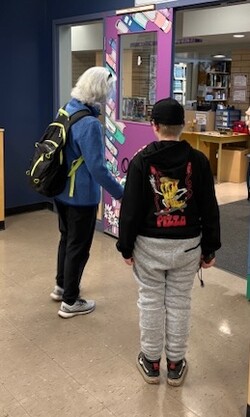Supporting Concept Development

Body Concepts
According to Fazzi (2014), it's important to help students with visual impairments, blindness, and deafblindness learn body concepts. This includes "the location, identification, and relationship of various parts and planes of the body, as well as an understanding of the range of movements and functions of those same body parts" (p. 253).
Ways to support the development of body concepts:
- Learn the body parts - play games and sing action songs like "Head, shoulders, knees, and toes" or the Hokey-Pokey (Have fun!)
- Support your student to learn movement skills in gym class such as jumping, hopping on two feet/one foot, walk, run, slide, and skip through games and action songs. (Make it fun!)
- Support your student to learn parts of the body through life skills and daily routines in class.
- E.g., "Lift your left foot to put your shoe on."
- E.g., "Give me your right hand so I can put your mitten on."
- E.g., "Put your hat on your head."
- E.g., "Your glue stick is at the top of your desk. Reach for it with your fingers and hand."
- E.g., "Grab the toy with your fingers."
- Teach your student to turn their body to face the speaker (point your toes, square your shoulders)
Talk to your O&M specialist, TSVI, and POPDB Teacher about strengthening body concepts with your student.
Printable Handout for Developing Body Concepts
Environmental Concepts
Most of the time, students with deafblindness require direct instruction to learn about the environment through direct, hands-on, structured experiences that the O&M specialist will provide (Fazzi, 2014). However, there are ways you can help support your student to learn about the environment.
Ways to support Environmental Concepts (Fazzi, 2014):
- Use descriptive language for environmental features that are present in the learning environment.
- E.g., "The wall of the school building is made of siding. It keeps the rain and snow out of the school."
- E.g., "The garden has a wooden fence around it to keep the dirt in the garden."
- Use real objects.
- E.g., learn about different types of brushes and when and why we use them, where do you store them when they aren't being used
- E.g., put together a first aid kit, exploring and learning about the items that are needed in emergencies
- E.g., learn about the different types of umbrellas and when and why they are used, where you store them, how they open and close, what they are made of
- Coordinate curricular units with the O&M specialist.
- E.g., in a unit about autumn, the O&M specialist might be able to do an O&M lesson that includes going outside to collect leaves for your experience book.
Talk to your O&M specialist, TSVI, and POPDB teacher about enhancing environmental concept development.
Printable Handout for Developing Environmental Concepts
Spatial Concepts
"Spatial concepts relate to the location or position of stationary and moving elements in the environment" (Fazzi, p. 256). It is important to be able to know where you are in relationship to other people, places, and important things so that you can move purposefully through the environment. Sensory awareness, body concepts, and environmental concepts contribute to our understanding of spatial concepts to put together the pieces to determine location, or placement of people and objects in the environment (Fazzi, 2014).
Some of these spatial concepts are complex and challenging to understand for individuals with visual impairments, blindness, and deafblindness. An O&M specialist is vital to learning these concepts.
Ways to support Spatial Concepts (Fazzi, 2014):
- Use descriptive language when talking about various environments.
- E.g., instead of handing the glue stick to your student, let them know it is on their right, near their hand.
- E.g., if your student is in a wheelchair, let them know that they are waiting behind student A and in front of student B.
- Encourage your student to help out in the class environment.
- E.g., your student might help a small group of peers make a bulletin board. Use terms during the activity such as bottom, top right corner, beside, below, between, top, next to, underneath, etc.
- Let your O&M specialist and Teacher for Students with Visual Impairments (TSVI) know about upcoming curricular units. They may be able to get supplemental hands-on materials or offer real life experiences to support the unit.
- Listen to your O&M specialist and follow their instructions for supporting spatial concepts.
Fazzi, D. L. (2014). Orientation and mobility. In C.B. Allman & S. Lewis (Eds.), ECC essentials: Teaching the expanded core curriculum to students with visual impairments, (pp. 248-323), AFB Press.